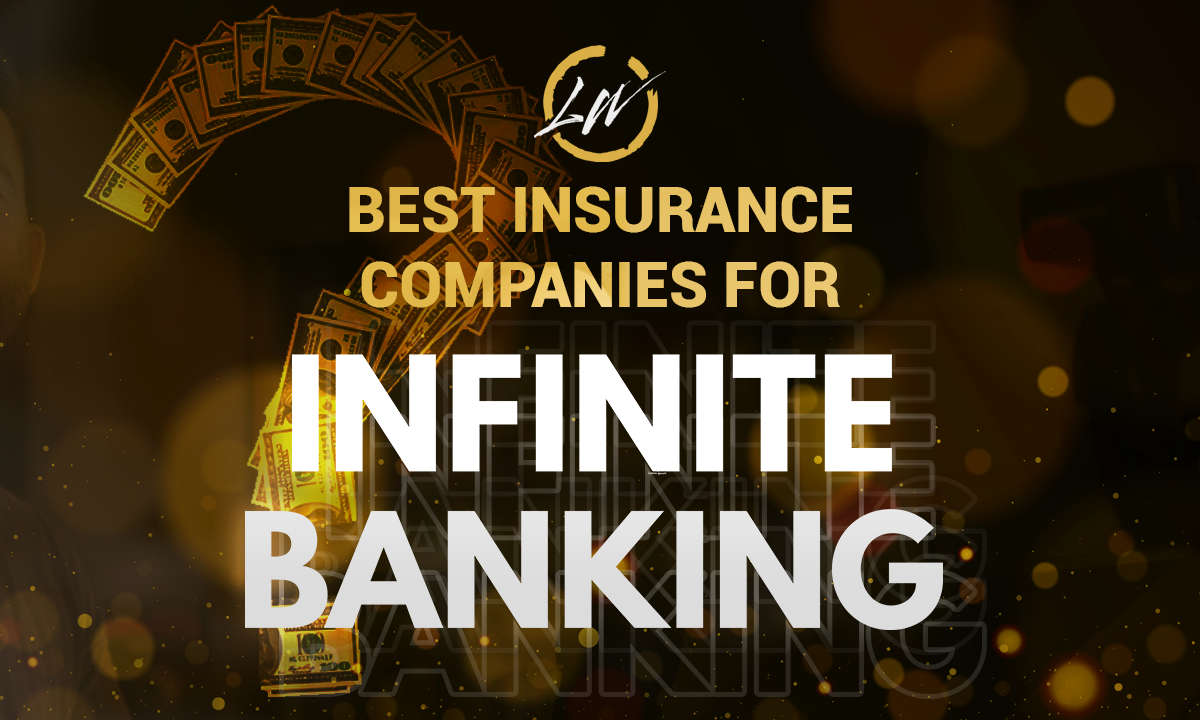Today, we’re diving into the best insurance companies for infinite banking and other frequently asked IBC questions. Whether you’re new to the concept or a seasoned practitioner, there’s always something new to learn, so buckle up and get ready to expand your financial horizons!
But before we dive in, let me remind you that your participation is crucial! If you have burning questions of your own, don’t hesitate to drop them in the comments of our youtube video “Top 5 FAQs About Infinite Banking” or shoot us an email at nate@livingwealth.com. Your input helps shape the content and ensures we’re addressing topics that matter to you.
So, without further ado, let’s jump into the first question.
Question 1: How do I decide what company to work with for infinite banking?
When you start your infinite banking journey, one of the initial decisions you’ll face is selecting the best insurance companies for infinite banking to partner with. The most important thing is choosing a mutual insurance company that offers dividend-paying whole life policies.
Mutual life insurance companies operate differently from other insurance policies. As mutual entities, they are owned by policyholders rather than shareholders, which often translates to a more customer-centric approach. These companies typically distribute a portion of their profits to policyholders in the form of dividends, making dividend-paying whole life policies an essential of infinite banking.
It’s also important to highlight the flexibility in practicing infinite banking with various insurance companies. While the principles of infinite banking remain consistent across different providers, each company may offer unique policy features, riders, and customer service experiences. This flexibility allows individuals to tailor their infinite banking strategy to align with their specific financial goals and preferences.
When it comes to selecting an insurance company for infinite banking, we recommend taking a holistic approach. Consider factors such as financial strength ratings, company history, policy costs, and dividend performance.
Additionally, think about your individual needs and long-term objectives. Are you looking for maximum cash value accumulation, flexibility in premium payments, or specific rider options? Evaluating these aspects will help you make an informed decision that suits your financial situation and aspirations. Remember, the right insurance company can significantly impact your infinite banking journey, so take the time to explore your options and choose wisely.
Question 2: How does my policy continue to grow even when I borrow from it?
It’s a common question among those exploring infinite banking: How does my policy keep growing even when I borrow from it? It’s kind of parallel to borrowing against home equity.
Imagine you own a home and have built up equity over time. You decide to take out a home equity loan, using your equity as collateral. Despite borrowing against the value of your home, its overall worth continues to appreciate, thanks to factors like market conditions and property improvements.
Similarly, in infinite banking, policyholders leverage their cash value—the accumulated savings within their whole life insurance policy—as collateral to receive loans from the insurance company. These loans are typically offered at competitive interest rates and are secured by the cash value itself. Here’s where the magic happens: even when you borrow against your policy’s cash value, the underlying cash value continues to participate in the growth of the policy.
This occurs because the insurance company doesn’t actually withdraw your cash value when you take out a loan. Instead, they use it as security while providing you with access to funds. Meanwhile, your policy’s cash value remains intact and continues to earn interest and dividends, contributing to its ongoing growth.
In essence, borrowing from your policy allows you to access funds for various financial needs while preserving the growth potential of your cash value. It’s a unique feature of whole life insurance policies that makes infinite banking such a powerful wealth-building tool. So, rest assured that your policy can continue to flourish even as you utilize it to finance other opportunities and endeavors.
Question 3: What is the difference between direct recognition and non-direct recognition?
Understanding the nuances of direct recognition and non-direct recognition is crucial when delving into the world of infinite banking.
Direct Recognition:
Direct recognition refers to a policy feature where the insurance company recognizes and adjusts dividends differently based on whether the policyholder has taken out loans against their policy’s cash value.
In direct recognition policies, the insurance company maintains separate dividend scales for policies with and without outstanding loans. These dividend scales are often tied to the policy’s loan rate, reflecting the company’s acknowledgment of the borrowed funds.
For policies with loans, the dividend scale may be adjusted downwards to reflect the fact that the policyholder is effectively using their cash value as collateral for the loan. This adjustment ensures that policyholders with loans receive dividends commensurate with the interest rate charged on their loans. Conversely, policies without loans may enjoy higher dividend rates since there’s no need to account for loan-related considerations.
Non-Direct Recognition:
On the other hand, non-direct recognition policies adopt a simpler approach. Regardless of whether a policyholder has taken out loans against their policy, the insurance company applies a single dividend scale to all policies within a particular product line. This means that the presence of loans doesn’t affect the dividend rates received by policyholders. In essence, non-direct recognition policies maintain consistent dividend payouts regardless of loan activity.
Choosing between direct recognition and non-direct recognition policies involves weighing the potential impact on dividend earnings and overall policy performance. While direct recognition policies offer transparency regarding dividend adjustments tied to loan activity, non-direct recognition policies provide uniformity and simplicity in dividend calculations.
Ultimately, the decision between direct recognition and non-direct recognition relies on individual preferences, risk tolerance, and long-term financial goals. By understanding the differences between these policy features, policyholders can make informed choices that align with their unique financial circumstances and objectives.
Question 4: How do I design my policy, considering base premium size and other factors?
Designing an infinite banking policy involves strategic decision-making regarding the size of the base premium and other essential factors.
Debate Between Base Premium Size:
A common dilemma in policy design revolves around the allocation of premiums between the base policy and paid-up additions (PUAs). Some advocate for a larger base premium, while others prefer a smaller base premium supplemented by substantial PUAs. The former approach prioritizes building cash value within the base policy, while the latter aims to accelerate cash value growth through PUAs.
Aligning Policy Design with Financial Goals:
When determining the optimal policy design, you should consider their financial goals, risk tolerance, and long-term objectives. If you’re looking for faster cash value accumulation in the early years, you may opt for a policy with a smaller base premium and larger PUAs. On the other hand, if you’re prioritizing stability and predictability, you may lean towards a policy with a larger base premium and modest PUAs.
Understanding Pros and Cons:
It’s important to understand the pros and cons of each design approach before making a decision. A policy with a larger base premium offers higher initial death benefits and provides a stable foundation for long-term growth. However, it may take longer to accumulate significant cash value compared to a policy with substantial PUAs. On the other hand, policies with smaller base premiums and larger PUAs may experience rapid cash value growth early on but could entail higher initial premiums and lower death benefits.
By weighing these factors and consulting with a knowledgeable financial advisor, you can tailor your policy design to align with your unique financial circumstances and objectives.
Question 5: Can I run all my finances through my policy?
A lot of people are curious about the extent to which they can integrate infinite banking into their financial strategies. Questions often come up regarding using policies for expenses, investments, savings, and more. While infinite banking offers flexibility,
While infinite banking offers flexibility, it’s important to exercise caution and thoroughly evaluate your individual circumstances before fully incorporating policies into financial strategies, consider factors such as their income, expenses, risk tolerance, and long-term financial goals before making decisions. Because infinite banking can be a powerful wealth-building tool, it’s not a one-size-fits-all solution.
We highly recommend starting with your free cash flow. Once you’ve paid all your expenses, and you have money leftover that you aren’t using, then you can start with one policy and gradually incorporate policies based on personal financial goals.
Beginning with a conservative strategy allows you to familiarize yourself with the mechanics of infinite banking while minimizing risk. As confidence grows and financial circumstances evolve, additional policies can be integrated into the strategy.
While the choice of insurance company is important, the true success of infinite banking lies in how effectively you utilize the system. Rather than fixating solely on specific companies, it’s crucial to focus on aligning infinite banking practices with personal financial objectives and lifestyle.
In essence, understanding the nuances of infinite banking and leveraging its benefits requires a proactive approach, thoughtful consideration of individual circumstances, and a commitment to ongoing education and adaptation. With the right mindset and guidance, infinite banking can serve as a powerful tool for achieving financial freedom and prosperity. If you’re interested to learn more about how infinite banking works, check out our free infinite banking course, it covers everything you need to know from A to Z.






